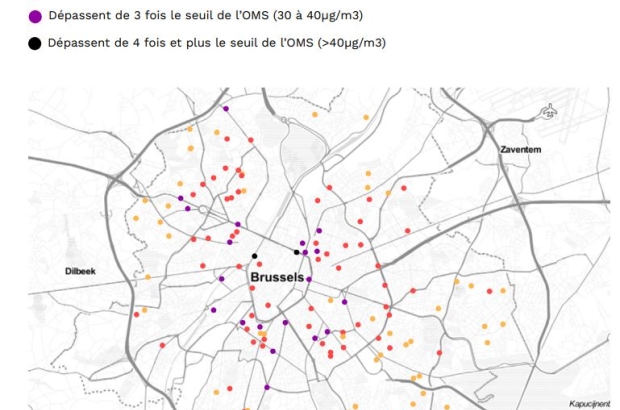- Daily & Weekly newsletters
- Buy & download The Bulletin
- Comment on our articles
Air quality report paints a bleak picture of pollution in Brussels
A year-long collaborative science campaign to monitor the concentration of nitrogen dioxide (NO2) in the Brussels air shows a dangerous level of the polluant, according to a report released by non-profit organisation Air Researchers (Les chercheurs d’air).
The report, seen exclusively by The Bulletin, details how NO2 levels in all areas of the Brussels Capital Region where measuring instruments were deployed exceeded World Health Organization (WHO) recommendations on pollution.
Some 60 Brussels residents and 70 schools took part in the study. It was the first time in Europe that concentrations of NO2 were measured by citizens at so many sites – 130 in total – and over such a long period.
The first so-called “passive” instruments - small plastic tubes left outside for a period of time that absorb, sponge-like, NO2 in the air – were installed in Brussels in October 2020. Each month, the tubes were replaced with new ones and the absorption of NO2 in the old tubes was analysed by scientists at local universities. The study concluded in October 2021.
From November 2020 to October 2021, over 100 of the monitoring sites in Brussels recorded levels of NO2 that twice exceeded those set in the WHO recommendations, ranging from just over the 10 µg/m3 level to levels in the high 20s. Around 20 sites recorded average NO2 concentrations above 30µg/m3, which is at least three times the WHO guideline, while the remainder reported concentrations four times higher than the recommended level.
The WHO recommendations for NO2 sets the quantity at 10 µg/m3, in line with the latest scientific data on the effects of air pollution on health, while the EU sets a slightly different level of 40 µg/m3 based mainly on technical feasibility and the costs associated with compliance. Discussions on a review of the EU standards in line with WHO recommendations are ongoing.
The study by Air Researchers is just one being undertaken as part of the Brussels Clean Air Partnership, launched by the Bloomberg Philanthropies Foundation, the Brussels-Capital Region, Brussels Environment and the 19 municipalities. The partnership brings together various Brussels initiatives on air quality, such as Cureuzenair and Babel'Air. The results of the Curieuzenair campaign, carried out in 3,000 locations in Brussels, will complement the campaign by Air Researchers and give a wider picture of the air quality situation in the Brussels region. The results of this study are expected in mid-March.
In their report, Air Researchers said they were particularly concerned about the levels of NO2 recorded around schools and playgrounds, as well as public institutions such as hospitals and care homes. Children and people with health issues are particularly at risk from air pollution.
Each year, NO2 is responsible for several hundred premature deaths. In a study of over 800 European urban areas, the Brussels region is the eighth most affected by the pollutant. Efforts are being made to improve air quality in the Belgian capital, for example with the creation in 2018 of the Low Emission Zone (LEZ), which limits access to the region by the most polluting vehicles. But the new report suggests that these efforts are not enough and that initiatives to expand the LEZ, ban diesel cars from zones in the city by 2025 and petrol cars by 2030 should be accelerated to improve public health.
The NGO also called on the 19 municipalities to increase the number of pedestrian streets in their territory, especially where schools are located. In general, the report recommended an increase in the space reserved for active and shared mobility, to speed up the electrification of vehicles indispensable for the mobility of people living, working or passing through Brussels, such as buses, vehicles for people with reduced mobility, taxis, etc, and to increase communication on the dangers of air pollution and the solutions available to combat it.
“As we have seen with the COVID-19 pandemic, it is very difficult to combat what is invisible,” writes Pierre Dornier, the author of the report. “Unlike the coronavirus, however, air pollution can be made visible, allowing us to identify its sources and take precise and appropriate measures to combat it.”
“The interest of this campaign is threefold. First, it teaches us more about the quality of the air we breathe in Brussels. Secondly, the results of this campaign will also help us to identify possible black spots that we will then make a priority for our action. And thirdly, in a more general way, the data obtained during this project will be used to strengthen the systems for modelling air pollution in Brussels and, thus, to better predict future urban development or pollution peaks.”




















Comments
Have they banned factories and others from burning their rubbish and letting the smoke and fumes shoot unfiltered into the air? Stop putting all the blame on cars and other vehicles.